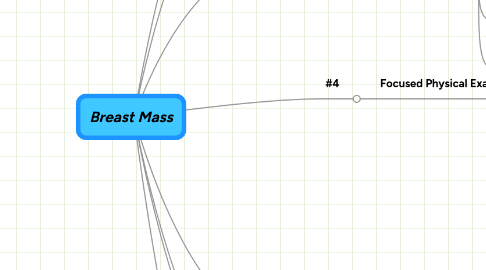
1. #2
1.1. Think of the differential...
1.1.1. benign dz
1.1.1.1. fibrocystic dz
1.1.1.2. mastitis
1.1.1.2.1. must follow carefully, because...
1.1.1.3. fat necrosis (2/2 trauma)
1.1.2. benign neoplasms
1.1.2.1. fibroadenoma
1.1.2.1.1. on PE, feels like...
1.1.2.1.2. most common in women...
1.1.2.2. intraductal papilloma
1.1.2.2.1. MCC of...
1.1.2.3. phylloides tumor
1.1.2.3.1. notable characteristics...
1.1.2.4. LCIS
1.1.2.4.1. what does incidental finding of LCIS say about breast cancer risk?
1.1.3. malignant neoplasms
1.1.3.1. DCIS
1.1.3.1.1. radiographic appearance...
1.1.3.2. invasive ductal
1.1.3.3. invasive lobular
1.1.3.3.1. more likely to be...
1.1.3.4. inflammatory
1.1.3.4.1. characteristic PE findings...
1.1.3.5. Paget's dz
1.1.3.5.1. how often is a mass also present?
1.1.3.5.2. is actually what type of ca?
1.1.3.6. sarcoma
2. #1
2.1. ABCs
3. #3
3.1. Take a history...
3.1.1. age/weight
3.1.1.1. increased risk of BrCA with increasing age and obesity
3.1.2. HPI
3.1.2.1. Mass
3.1.2.1.1. o number & location, o duration, o chg in size, o pain, o chg’s with menses/breastfeeding (fibrocystic disease), o discharge (intraductal papilloma) – unilateral vs. bilateral, clear vs. bloody, trauma, red/warm
3.1.2.2. Related sx
3.1.2.2.1. o fever/chills (mastitis) o weight loss (cancer)
3.1.2.3. Gynecologic
3.1.2.3.1. o age at menopause o age at menarche o # of kids o age at first birth o breastfeeding
3.1.3. PMH
3.1.3.1. previous hx of breast disease, ovarian cancer, endometrial cancer (BRCA1/2)
3.1.4. PSH
3.1.5. Meds
3.1.5.1. HRT, contraceptives
3.1.6. FH
3.1.6.1. hx of cancer, especially breast/ovarian/ endometrial/prostate cancer (BRCA ½)
3.1.7. SH
3.1.7.1. radiation exposure
3.1.8. ROS
3.1.8.1. o fever o weight loss o bone pain (bone mets) o change in mental status (brain mets) o difficulty breathing/SOB (lung mets) o abdominal pain (liver mets)
3.1.9. HMA
3.1.9.1. last MMG, breast self-exams
4. #4
4.1. Focused Physical Exam...
4.1.1. Vital Signs, Gen Appearance
4.1.2. Breast exam
4.1.2.1. Breast tissue
4.1.2.1.1. In four positions (sitting, supine, arms\rat waist, pull arms forward)...
4.1.2.2. Mass
4.1.2.2.1. Palpate & describe (cystic/solid, mobile/fixed)
4.1.2.3. NAC
4.1.2.3.1. Examine for nipple discharge or areolar involvement
4.1.2.4. Lymph nodes...
4.1.2.4.1. Palpate axillary, supraclavicular, and cervical nodes
5. #5
5.1. Workup...
5.1.1. If <30 yo...
5.1.1.1. can observe for resolution over 1-2 menstrual cycles. if mass persists...
5.1.1.1.1. do an US – most will be fibroadenomas or fibrocystic disease; if neither...
5.1.2. If >30 yo...
5.1.2.1. If mass feels cystic...
5.1.2.1.1. do an US with aspiration. if no concerning findings...
5.1.2.2. If it’s a solid mass or persists after aspiration or there is blood in aspirate...
5.1.2.2.1. Do bilateral mammography & core biopsy o core biopsy can be done in-office, get ER/PR/Her2Neu status o Worrisome MMG = spiculation, calcifications, irregular borders o 15% of people with clustered microcalcs on MMG have a malignancy If it’s very suspicious for malignancy on mammography, can do an excisional biopsy With nipple discharge can get galatography (retrograde contrast injection)
6. #6
6.1. Staging
6.1.1. TNM staging
6.1.1.1. • Primary tumor o T1 = tumor <2 cm o T2 = tumor >2 but <5 cm o T3 = tumor >5 cm o T4 = tumor of any size with extension into chest wall or skin • Regional lymph nodes o N0 = no palpable axillary nodes o N1 = mets to movable axillary nodes o N2 = mets to fixed, matted axillary nodes • Distant metastases o M0 = no distant mets o M1 = distant mets
6.1.2. clinical staging
6.1.2.1. Stage I = tumor less than 2 cm, no nodes 93% 5-year survival Stage II = tumor less than 2 cm with mobile nodes, tumor 2-5 cm with no nodes or mobile nodes, tumor greater than 5 cm with no nodes 72% 5-year survival Stage III = tumor greater than 5 cm with mobile nodes, any tumor with fixed nodes, any tumor + internal mammary nodes 41% 5-year survival Stage IV = distant mets (incl. supraclavicular nodes) 18% 5-year survival
6.1.3. met workup
6.1.3.1. CBC
6.1.3.2. LFTs
6.1.3.3. Ca++, AlkPhos
6.1.3.4. BRCA testing (if +FH) --> may change operation to B/L mastectomy
6.1.3.5. CXR --> lung mets
6.1.3.6. bone scan (if +bone pain) --> bone mets
6.1.3.7. abdomincal CT (if +abdominal pain) --> to check for liver mets
7. #7
7.1. Treatment
7.1.1. General themes
7.1.1.1. Radical mastectomy
7.1.1.1.1. define...
7.1.1.1.2. only necessary when...
7.1.1.2. Requirements for XT post-MRM
7.1.1.2.1. Radiation to chest wall if: 1) chest wall invasion 2) tumors >5 cm 3) positive margins
7.1.1.2.2. Radiation to axilla if >4 positive LN
7.1.1.3. when do a SLNB with a lumpectomy+RT?
7.1.1.3.1. when the BrCA is INVASIVE & if axillary LN are not palpably suggestive of mets (in that case just do dissection)
7.1.2. Specific diseases
7.1.2.1. Fibroadenoma
7.1.2.1.1. observation or elective removal without previous biopsy
7.1.2.2. Fibrocystic disease
7.1.2.2.1. aspirate cysts if symptomatic, if mass remains can do a biopsy
7.1.2.3. Mastitis
7.1.2.3.1. ATBs and drainage if abscess exists
7.1.2.4. Phylloides tumor
7.1.2.4.1. local excision with wide margins, can have malignant potential (chemo and radiation are not effective)
7.1.2.5. Intraductal papilloma
7.1.2.5.1. ductogram with excision of duct and ductal system
7.1.2.6. Paget’s
7.1.2.6.1. MMG and exam for sub-areolar mass (present 50% of the time), then work-up mass. If no mass is present, biopsy nipple lesion Paget cells: excision of NAC or RT
7.1.2.7. Atypical ductal hyperplasia
7.1.2.7.1. lumpectomy + RT o 4-5 times higher risk of developing cancer o 15-50% prove to be malignant
7.1.2.8. DCIS
7.1.2.8.1. lumpectomy + RT or MRM o Histology (comedo), mulitfocal disease, or large lesion could sway you to do a SLNB o 3 mm margin o 10-20% of DCIS has infiltrative component at excision
7.1.2.9. LCIS
7.1.2.9.1. surveillance (if patient is high risk, can try prevention with tamoxifen)
7.1.2.10. Inflammatory
7.1.2.10.1. neo-adjuvant chemo
7.1.2.10.2. MRM
7.1.2.10.3. adjuvant radiation
8. #8
8.1. Follow-up care
8.1.1. MMG every 6 months for 2 years, followed by yearly MMG
8.1.2. Annual CXR and LFTs
